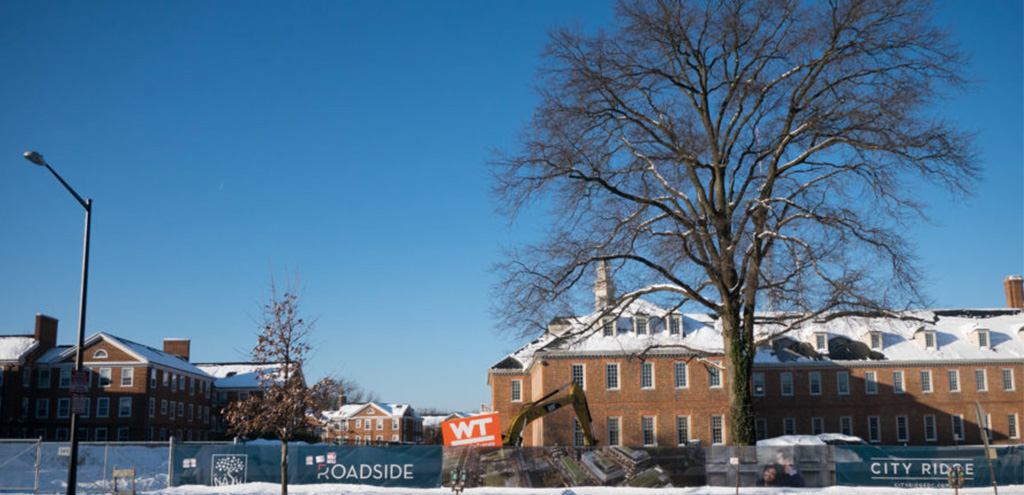THE LEAFLET

Casey Trees and a 600,000 Pound Tree on the Move Featured in WAMU
A 65-foot-tree on the old Fannie Mae campus in Northwest D.C. was moved 100 feet north. To find out how, why, and what we had to say about it, check out this feature by Jacob Fenston and WAMU (plus we added in some of our own photos and video below!):
How (And Why) Do You Move A 600,000 Pound Tree?
If you happened to walk down Wisconsin Avenue earlier this month, you might have noticed a towering oak tree in front of the old Fannie Mae headquarters. In the morning, the 65-foot-tall tree stood on the south edge of the property, where it was planted decades ago. By the end of the day, the tree had moved almost 100 feet north.
“It’s a beautiful day to be moving a tree!” says Paul Cox, on the chilly, slightly windy afternoon.
For Cox, it’s just another day in the office. He works for Environmental Design, a Texas-based company that specializes in relocating large trees.
Cox and his team are moving this pin oak tree to make way for a mixed-use development. Under a 2016 D.C. law, this tree, and others of its size, can’t be cut down, as long as they’re healthy. Any tree with a circumference of 100 inches or more is considered a heritage tree and cannot be removed, under the Tree Canopy Protection Amendment Act of 2016.
Earl Eutsler, who runs D.C.’s urban forestry division, says the law is starting having a real impact. “This is the first example of a tree being relocated or transplanted to make way for development while also preserving the tree,” said Eutsler. “So we’re really excited.” Other developers have chosen to build around trees, and a few have been issued hefty fines — starting at $30,000 — for illegally removing heritage trees.
Eutsler shares his excitement about moving the tree and thanks the many, many folks that helped make the Tree Canopy Protection Amendment Act of 2016 a reality.
So how do you move a 65-foot-tall tree?
Very slowly.
“It’s kinda like watching paint dry,” says Cox, as he watches his crew at work around the tree. “Generally speaking, when things are going according to the plan, which they do about half the time, it’s about 100 feet per hour.”
Workers began more than a year ago, pruning the tree’s roots. In recent weeks, they excavated the area around the tree, then shoved 35 large metal pipes under the roots, creating a platform. Then they wedged a series of long rubber air bags under the pipes. Once ready to move the tree, workers inflate the air bags, lifting the tree slowly out of the ground.
As the tree rises, it tilts toward the street. But nobody seems concerned.
When all the air bags are full, two excavators are chained to the tree’s platform. They give a tug, and the enormous living organism, as tall as a six-story building, begins its journey, rolling over the inflated bags. Cox says the tree and root ball likely weigh around 600,000 pounds.
Why move a tree?
When Fannie Mae sold its headquarters at 3900 Wisconsin Avenue, NW, about two years ago, developers snapped up the 10-acre, sparsely built campus. Richard Lake, co-founder of Roadside Development, says the project will include roughly 700 residential units and 200,000 square feet of commercial space, including the city’s first Wegmans grocery store. The old Fannie Mae building, facing Wisconsin, will become a hotel or office space, with a park-like square in front.
The pin oak tree was sitting smack in the way of a driveway for Wegmans delivery trucks.
If the project had been done a few years ago, developers could have applied for a permit, paid a fee, and chopped down the oak with approval from the city. But under the 2016 heritage tree law, that’s no longer an option.So Lake’s team decided to relocate this tree, and two other heritage trees on the property — moving them all to what will be a grassy area right in front of the main building.
It’s not cheap. “I think our total cost is close to $200,000 per tree,” says Lake.
The price tag is worth it, according to Lake, even though it’s much more than the fines would be for breaking the law. These big, mature trees, he says, create a sense of place, a sense of history.
“We’re trying not to create a fake place; we’re trying to create as real a place as we can, as authentic a place as we can,” he says.
Jessica Sanders, director of science and policy at the non-profit Casey Trees, says as trees mature, the benefits they provide increase exponentially.
“Everyone can understand on a hot summer day, you walk under a very large tree, it’s beautiful. It’s shaded, it’s cooler. Whereas a newer tree, you don’t experience that right away. So trees, much like humans, take a long time to mature and develop.”
Sanders says that’s why it’s important to protect these trees. She says D.C.’s heritage tree law is one of the most protective in the nation.
Mark Buscaino, executive director of Casey Trees, says getting there was no easy thing.
“I think it’s the culmination of 20 years of struggle in the city,” says Buscaino, who used to be the city’s chief forester. “At that time, the city’s budgets were at a low. There were 5,000 dead or dying trees on the streets, cars were getting crushed. I mean the list goes on and on,” says Buscaino.
Now, he says, the District is making progress toward its goal of increasing tree cover to 40 percent of the city. “It speaks not just to the fact that the city cares about its trees, but it speaks about a cultural change.”
Top Article image is courtesy of Jacob Fenston/WAMU.